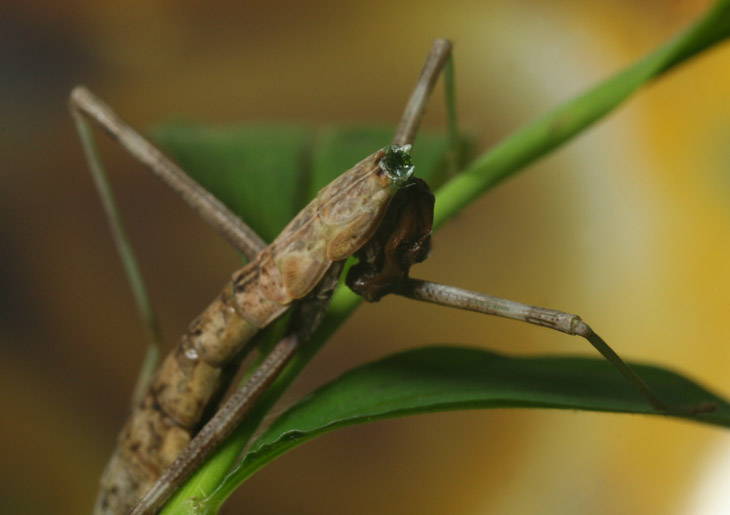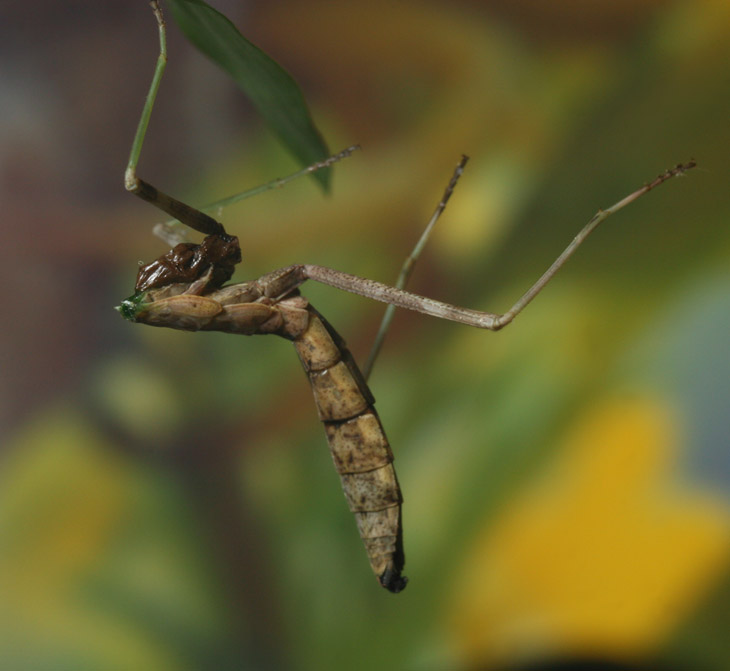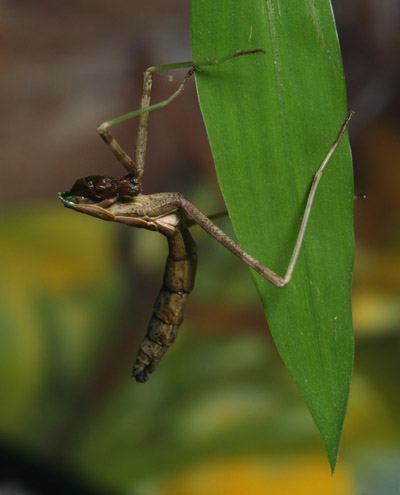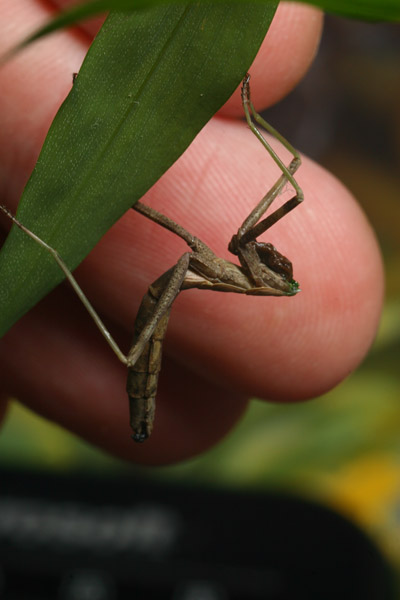Since I had to get up early this morning, naturally I was up late last night checking out the little pond in the yard. The larger frogs have all moved on, to be replaced by five smaller frogs (all green frogs, Lithobates clamitans, I believe,) and a huge number of tadpoles and newborn minnows. But the thing that captured my attention was, once again, an insect.
Atop the leaves of the pond plants I found a small carcass, curiously because the plants were growing from the middle of the pond, so access by any non-flying arthropod was difficult, to say the least. I reached over to pick it up and it reacted, struggling feebly against the contact, notable because its head and upper thorax were missing. Identifying it quickly as a Carolina mantis (Stagmomantis carolina,) I carried it inside to do a quick photo session. I shouldn’t have to explain myself anymore so I’m not going to.

Now here’s the thing: most non-arthropod predators, like frogs and birds and such, would likely have consumed the body completely if they managed to get enough of a hold to remove the head and forelegs like this (the brown blobs you see beneath the wound are internal organs, still vaguely attached.) And of the arthropod predators, the vast majority would have drained the fluids from it intact – things like spiders and assassin bugs. There’s really not that many foes that might partially consume a mantis like this, and the primary suspect is another mantis.

Now, you may have heard the folklore about praying mantises, how the female bites off the head of the male during copulation, and the male continues to perform his duty without the benefit of the primary nerve center; it seems extraordinary, until we remember how little thinking males of our own species are capable of in similar circumstances. But it’s also mostly folklore; only one species is known to do it, and not on a regular basis – it is largely believed to happen only if the female is in need of greater sustenance. Our human perspective still generally finds this somewhere between creepy and horrifying, but nature produces some interesting dynamics. What evolves are traits to further a species’ own genetic line, so once the male has impregnated a female, this goal is met on his end at least. The female must survive to produce eggs, however, and this takes a lot of food, so the male can serve double duty, and by doing so, even when he dies, he still helps foster his own genetic line. Neither one, of course, will be around to help raise the chillun, so the female’s legacy is as guaranteed as it can be once the egg sac is created. For more social species, however, living past childbirth is not only necessary just to raise the child, but may foster survival further by providing a mutually supportive environment for the entire pack or school or tribe or whatever, and that’s what we’re used to.
 All of this is fascinating, at least to me, but it’s also not really germane to this immediate situation, for one simple reason: this specimen was a juvenile, so no mating behavior was about to take place. What I consider most likely is that it encountered another mantis, quite possibly one of the Chinese mantids (Tenodera sinensis,) but something happened to interrupt the meal, and so it was only partially consumed. I searched the plants for any evidence of another, still wondering how either of them might have crossed the significant moat that is our backyard pond, before realizing that the victim here might have fallen from the overhanging branches. And there’s one other thing that could support this idea.
All of this is fascinating, at least to me, but it’s also not really germane to this immediate situation, for one simple reason: this specimen was a juvenile, so no mating behavior was about to take place. What I consider most likely is that it encountered another mantis, quite possibly one of the Chinese mantids (Tenodera sinensis,) but something happened to interrupt the meal, and so it was only partially consumed. I searched the plants for any evidence of another, still wondering how either of them might have crossed the significant moat that is our backyard pond, before realizing that the victim here might have fallen from the overhanging branches. And there’s one other thing that could support this idea.
See the image above, where the mantis is suspended by just one leg? I had been trying to position the tiny mantis on a small sprig of weeds for the image, and fumbled it, losing my (very gentle) grip. It fell from the uppermost branch of the sprig down to a leaf below and, to my amazement, snagged a toehold exactly as a complete mantis might, getting a grip in the milliseconds of contact as it bounced off the leaves. This toehold proved quite difficult to dislodge as well, and as I tried, something else occurred which astonished me even further: the other three (remaining) legs moved around and secured the mantid’s footing. That’s what you see here – I didn’t position it this way at all. Apparently, the ability to obtain and maintain a good grip, coordinating the movements of the legs together, does not reside within the brain of a mantis. As you can see, it’s not perfect, but it’s still pretty impressive for something lacking a head and shoulders and who knows what percentage of internal organs. And again, the whole “keep plugging away” folklore really does happen – not as often as is usually believed, but still occasionally, and those actions are all coordinated without the benefit of a brain too.
 One last frame, to demonstrate scale – now you understand why my handling of it wasn’t that secure. Yeah, I know, I should be an expert in handling tiny fragile insects by now, able to snag a fly in midair without harming it, restringing damaged spider webs and all that. But I’m still a guy, and there’s only so delicate that we’re supposed to be, you know?
One last frame, to demonstrate scale – now you understand why my handling of it wasn’t that secure. Yeah, I know, I should be an expert in handling tiny fragile insects by now, able to snag a fly in midair without harming it, restringing damaged spider webs and all that. But I’m still a guy, and there’s only so delicate that we’re supposed to be, you know?



















































